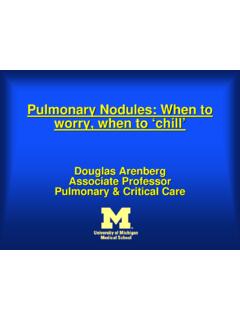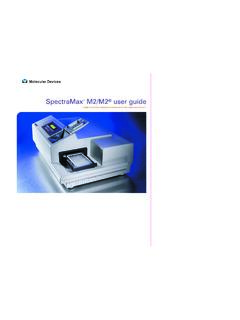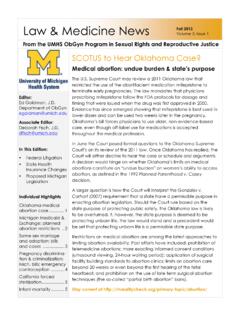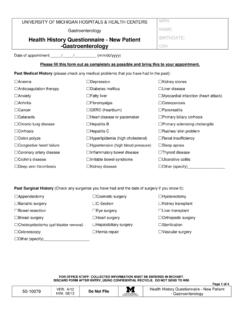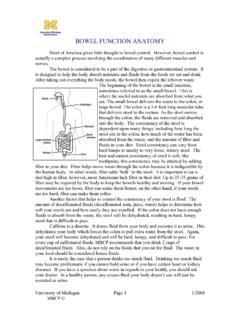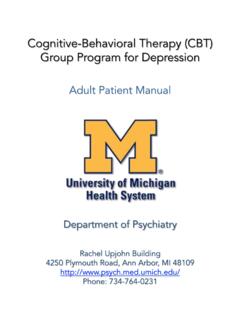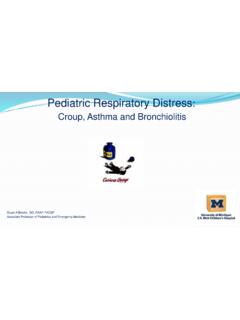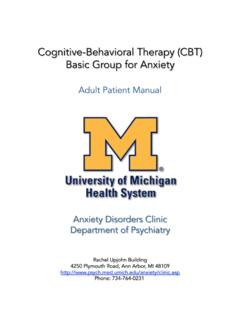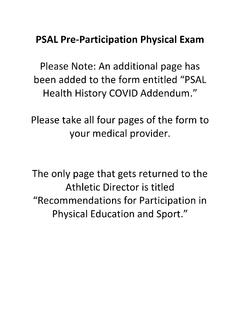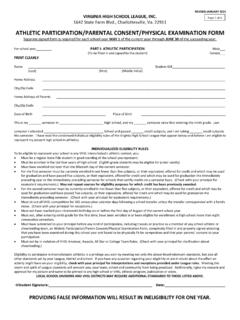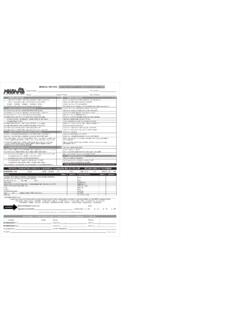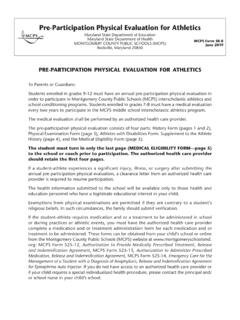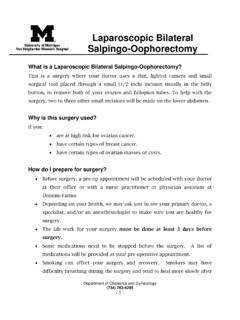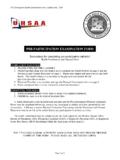Transcription of Diagnostic Approach to Hip Pain - University of Michigan
1 Diagnostic Approachto Hip PainZo J. Foster, MDOctober 3, 2018 DisclosuresI have nothing to Review examination of the hip, including special tests Discuss differential diagnosis for hip pain Consider special diagnoses not to be missedAnatomyImages from: SonosimCase 1: Anterior hip pain 15yo track athlete with worsening R groin pain tripped and fell in her yard a year ago, now with pain x 6 monthsdull constant achy pain, 4-5/10radiation to anterior thighhard to get comfortable at nighthard to go up and down stairs one at a timecan t run due to painbetter with ibuprofenno history of hip problems priorDifferential Diagnosis for Hip PainINTRA-ARTICULAR CAUSESEXTRA-ARTICULAR CAUSESL abral tearAdhesive capsulitisLoose bodies (including OCD lesions)Snapping hip (internal or external)Femoroacetabularimpingement (FAI)
2 Greater trochantericpain syndromeSynovitisPiriformis syndromeTearsof ligamentumteresOstetispubisChondral injurySportsherniaAvascular necrosisMyotendinousinjuriesAvulsion injuries (ASIS,etc)Stress fracturesNerve compression syndromesFrom: Poultsides, L. A., Bedi, A., & Kelly, B. T. (2012). An Algorithmic Approach to Mechanical Hip Pain. HSS Journal, 8(3), 213 224. of Hip Pain From: Wilson JJ, Furukawa M. Evaluation of the patient with hip pain. American Family Physician. 2014; 89(1): 27-34 Differential Diagnosis for Hip PainANTERIORLATERALPOSTERIORO steoarthritisGreater trochanteric pain syndromePiriformis syndromeFemoroacetabularimpingement(FAI) Externalsnapping hip (IT band)IschiofemoralimpingementHiplabralte arGreater trochantericbursitisSacroiliac joint dysfunctionIliopsoasbursitis (internal snapping hip)Gluteal muscle tear oravulsionLumbar radiculopathyFemoralneck stress fractureIliaccrest apophysisavulsionVascular claudicationOsteonecrosisIT band syndromeIschialapophysisavulsionMeralgia parestheticaFemoroacetabularimpingement( FAI)Hamstring muscle strain/avulsionAthletic pubalgia(sports hernia)
3 Loose bodies/chondral lesionsLegg-Calve-PerthesdiseaseSlippedc apital femoral epiphysisTransient synovitisSeptic arthritisHip pointerApophysealavulsion injuries (ASIS; AIIS)Functional Tests of the HipSquattingGoing up and down stairs one at a timeCrossing the legs so that the ankle of one foot rests on the knee of the opposite legGoing up and down stairs two or more at a timeRunning straight aheadRunning and deceleratingRunning and twistingOne-legged hopJumpingImage from: 1: Exam Inspection Gait Muscular atrophy Pelvic symmetry Palpation Range of motion Special testsTypes of Abnormal GaitImage from: Lim MR, Huang RC, et. Al. Evaluation of the Elderly Patient with an Abnormal Gait.
4 J Am AcadOrthopSurg2007;15:107-117 CoxalgicGaitTrendelenburg GaitImages from: Lim MR, Huang RC, et. Al. Evaluation of the Elderly Patient with an Abnormal Gait. J Am AcadOrthopSurg2007;15:107-117 Exam: Palpation of Bony LandmarksIliac crestASISAIISG reater trochanterPubic tuberclePSISSI jointIschial tuberosityExam: Range of MotionImages from: SallisR. Examination Skills of the Musculoskeletal System. AAFP Clinical Procedures CMEExam: Strength Testing -Flexor MusclesIliopsoas psoasiliacusRectus femorisPectineusSartoriusAdductor longusAdductor brevisGracilisImages from SonosimExam: Strength Testing -Extensor MusclesGluteus maximusHamstringsBiceps femorisSemimembranosusSemiteninosusGlute us mediusAdductor magnusImages from: SonosimExam: Strength Testing Adductor MusclesAdductor longusAdductor brevisAdductor magnusGracilisPectineusImage from: SonosimExam: Strength Testing Abductor MusclesTensor fasciae lataeGluteus mediusGluteus minimusGluteus maximusSartoriusImage from: SonosimExam.
5 Strength Testing Internal RotationAdductor longusAdductor magnusAdductor brevisGluteus mediusGluteus minimusTensor fasciae lataePectineusGracilisImage from SonosimExam: Strength Testing External RotationGluteus maximusObturator internusObturator externusQuadratus femorisPiriformisGemellussuperiorGemellu sinferiorSartoriusGluteus mediusImages from: SonosimExam: Special TestsLog Roll Passive assessment of internal and external rotation at the hip Positive test is pain or decreased range of motion Helpful for diagnosis of: Osteoarthritis Osteonecrosis Femoroacetabularimpingement Stress fractureImage from: Wilson JJ, Furukawa M. Evaluation of the Patient with Hip Pain.
6 Am Fam ;89(1):27-34. Exam: Special TestsFABER (Patrick s)Test Passive Flexion, ABduction, External Rotation of the hip joint Ipsilateral pain suggests an intra-articular problem or iliopsoas strain; contralateral pain suggests sacroiliac pathology; posterior pain suggests hip impingement (FAI)Image from: Wilson JJ, Furukawa M. Evaluation of the Patient with Hip Pain. Am Fam ;89(1):27-34. Exam: Special TestsFADIR Test Passive Flexion, ADduction, Internal Rotation of the hip joint Positive for FAI if it reproduces the patient s hip painImage from: Wilson JJ, Furukawa M. Evaluation of the Patient with Hip Pain. Am Fam ;89(1):27-34. Exam: Special TestsSnapping Hip Maneuver Passive flexion, external rotation and then extension of the hip Positive test is a palpable snap/click and reproduction of the patient s symptoms Can suggest iliopsoas bursitisImage from: Margo K, Dreznerj, MotzkinD.
7 Evaluation and Management of Hip Pain: An Algorithmic Approach . Journal of Family Practice. 2003; 52(8): : Special TestsRectus FemorisStretch Test Patient actively flexes the opposite hip to the chest while the leg behind examined is flexed at the knee over the edge of the exam table Positive test is extension of the resting leg at the knee Suggests tightness in the rectus femorismuscleImages from: Reid DC. Sports Injury Assessment and Rehabilitation. Philadelphia: Churchill Livingstone, : Special TestsThomas Test Patient actively flexes the opposite hip toward the chest Positive test is knee flexion in the extended leg Suggests tightness in the hip flexors and psoasImages from: Reid DC.
8 Sports Injury Assessment and Rehabilitation. Philadelphia: Churchill Livingstone, : Special TestsStinchfieldTest Straight leg raise against resistance (ptlifts leg to 45 while examiner applies downward force on the thigh) Positive test is reproduction of the patient s symtoms Helpful for diagnosis of: FAI SCFEI mage from: Wilson JJ, Furukawa M. Evaluation of the Patient with Hip Pain. Am Fam ;89(1):27-34. Case 1: ImagingCase courtesy of Mark Baumeier, DOCase 1: DiagnosisSlipped Capital Femoral Epiphysis (SCFE) One of the most commonly missed diagnoses in children Most common in 8-15yo Most common hip disorder in adolescents ( ,000) Associated with obesity, growth spurts and sometimes endocrine abnormalities Usually present with limping and poorly localized pain in the hip, groin, thigh or kneeCase 2.
9 Anterior Hip Pain 22yo collegiate field hockey player with tight hip flexor x 3 wksAnterior pain that she attributes to her hip flexorExacerbated by long training runsNot better with 4 days rest when team was travelingDull, achy pain that is becoming more constant History of prior stress fracture in tibia Suspected eating disorder though BMI is in normal rangeCase 2: DiagnosisFemoral Neck Stress Fracture Most common location for stress fracture in the femur Relatively rare; account for only 1-7% of all stress fractures Are high risk on the lateral aspect of the femoral neck Should be on the differential for exercise induced pain that is relieved by 3: Lateral hip pain 33yo RN with tightness in his L hipGestures in a c shape to the lateral hipSymptoms have been present for monthsStretching helpsTight sensation, not painful; no radiationNo trauma and no h/o same prior exercising daily for 1-2 hours, "sometimes more".
10 No rest days. "I feel like if I stop to rest I'll lose it."Differential Diagnosis for Hip PainANTERIORLATERALPOSTERIORO steoarthritisGreater trochanteric pain syndromePiriformis syndromeFemoroacetabularimpingement(FAI) Externalsnapping hip (IT band)IschiofemoralimpingementHiplabralte arGreater trochantericbursitisSacroiliac joint dysfunctionIliopsoasbursitis (internal snapping hip)Gluteal muscle tear oravulsionLumbar radiculopathyFemoralneck stress fractureIliaccrest apophysisavulsionVascular claudicationOsteonecrosisIT band syndromeIschialapophysisavulsionMeralgia parestheticaFemoroacetabularimpingement( FAI)Hamstring muscle strain/avulsionAthletic pubalgia(sports hernia)
